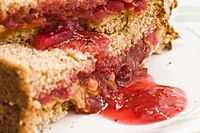Peanut butter and jelly sandwich
 | |
| Alternative names | PB&J |
|---|---|
| Course | Lunch, Dinner, or Snack |
| Place of origin | United States |
| Serving temperature | Room temperature |
| 320~ Calories kcal | |
A peanut butter and jelly sandwich (PB&J) consists of peanut butter and fruit preserves—jelly—spread on bread. The sandwich may be open-faced, made of a single slice of bread folded over, or made between two slices of bread. The sandwich is popular in the United States, especially among children; a 2002 survey showed the average American will eat 1,500 before graduating from high school.[1] There are many variations on the sandwich, starting with the basic peanut butter sandwich or jam sandwich.
Preparation[]
In basic preparation methods, a layer of peanut butter is spread on one slice of bread and a layer of fruit preserves is spread on another before the two sides are sandwiched together. (Jelly is a fruit-based spread, made primarily from fruit juice, while jam contains crushed fruit and fruit pulp.[2])
The water inherent to preserves can make the bread soggy, especially when the sandwich is prepared ahead of time as part of a bag lunch. To prevent this, the peanut butter can be spread first on both slices of bread. The fat in peanut butter will block the moisture from the preserves from entering the slices of bread. However, the preserves are now more mobile and can squirt out the sides. If the open sides are sealed, the preserves are thoroughly contained; this technique is utilized by the major manufacturers of sealed crustless sandwiches (e.g. "Uncrustables").
History[]

Peanut butter was originally paired with a diverse set of savory foods, such as pimento, cheese, celery, watercress, saltines and toasted crackers.[3] In a Good Housekeeping article published in May 1896, a recipe "urged homemakers to use a meat grinder to make peanut butter and spread the result on bread." The following month, the culinary magazine Table Talk published a "peanut butter sandwich" recipe.[4][5] An early recipe for a peanut butter and jelly sandwich appeared in the Boston Cooking School Magazine in 1901; it called for "three very thin layers of bread and two of filling, one of peanut paste, whatever brand you prefer, and currant or crabapple jelly for the other", and called it as "so far as I know original".[6] In the early 1900s, this sandwich was adopted down the class structure as the price of peanut butter dropped. It became popular with children with the advent of sliced bread in the 1920s, which allowed them to make their own sandwiches easily.[7]
Since World War II, both peanut butter and jelly have been found on US soldiers' military ration list.[8]
National Peanut Butter and Jelly Day occurs annually in the United States on April 2.[9]
Nutrition[]
A peanut butter and jelly sandwich that is made with two slices of white bread, two tablespoons each of peanut butter and grape jelly provides 403 kcal, 18 g fat, 58 g carbs, and 12 g protein, which is 27% of the Recommended Daily Intake of fat and 22% of calories.[10]
While roughly 50% of the calories are from fat, most of them come from monounsaturated fat and polyunsaturated fats, which the American Heart Association considers beneficial to heart health.[11]

Sandwich preparation, where each slice of bread is protected by a layer of peanut butter

Close-up view of a cut peanut butter and jelly sandwich showing soggy whole wheat bread
See also[]
References[]
- ^ "PB&J is A-OK". Prepared Foods 171.10. Prepared Foods. October 2002. p. 32. Retrieved August 28, 2017.
- ^ "What's the difference between jam, jelly and fruit preserves?". TODAY.com. Retrieved 2019-09-02.
- ^ Peanuts: The Illustrious History of the Goober Pea. University of Illinois Press. 2002. p. 35. ISBN 9780252025532.
- ^ McWilliams, Mark (6 April 2012). The Story Behind the Dish: Classic American Foods. ABC-CLIO. p. 166. ISBN 9780313385100.
- ^ Lau, Maya (June 7, 2013). "Who Made That?". New York Times Magazine.
- ^ Julia Davis Chandler, "Peanuts and pralines", Boston Cooking-School Magazine 6:4:188-189 (November 1901) as quoted in Freedman, Paul; Haley, Andrew P.; Lim, Imogene L.; Albala, Ken; Elias, Megan (November 3, 2017). "The History of Five Uniquely American Sandwiches: From tuna fish to the lesser-known woodcock, food experts peer under the bread and find the story of a nation". Smithsonian. Retrieved December 16, 2019.
- ^ Olver, Lynne. "Peanut". The Food Timeline.
- ^ Why Do Donuts Have Holes?. Citadel Press. 2004. p. 127. ISBN 9780806525518.
- ^ Ward, Matthew (April 2, 2019). "April 2 is National Peanut Butter and Jelly Day". WMC News. Retrieved April 3, 2019.
- ^ Jegtvig, about.com, undated, "How Nutritious is a PB&J?", archived from the original, January 13, 2006. Accessed December 20, 2017.
- ^ Corleone, Jill. "Are Peanut Butter & Jelly Sandwiches Healthy?". Retrieved 31 March 2012.
External links[]
| Wikimedia Commons has media related to Peanut butter and jelly sandwiches. |
| Wikibooks Cookbook has a recipe/module on |
- American sandwiches
- Vegan cuisine
- Peanut butter
- Food combinations



